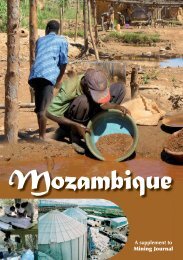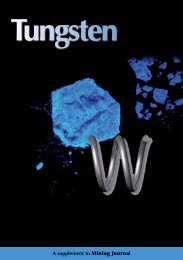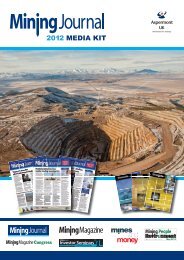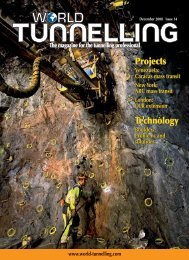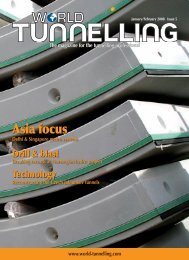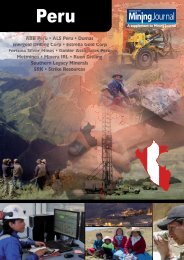Download Supplement PDF - Mining Journal
Download Supplement PDF - Mining Journal
Download Supplement PDF - Mining Journal
You also want an ePaper? Increase the reach of your titles
YUMPU automatically turns print PDFs into web optimized ePapers that Google loves.
est<br />
frica<br />
6%<br />
Europe 4% FSU/<br />
3%<br />
Mongolia<br />
8%<br />
Sub-Saharan<br />
Africa<br />
Other countries account for about 6%<br />
February 2012<br />
EXPLORATION SPECIAL<br />
Russia 3%<br />
China<br />
Australia<br />
16% The 6% increased efforts in 7% West Africa translated into<br />
gold receiving more than half the African exploration<br />
total in each of the past two years. In contrast, since<br />
accounting for about a third of African budgets in<br />
2004, diamond allocations dropped to an all-time low<br />
of 6% in 2011, primarily owing to waning diamond<br />
spending in Sub-Saharan Africa, as many companies<br />
focus more in countries such as Russia and India.<br />
Exploration spending in Australia kept pace with<br />
the world average increase in 2011, maintaining the<br />
country’s share of the total at about 13%, despite<br />
mining reform at the national and state levels<br />
dominating national headlines for much of the year.<br />
Spending in Western Australia accounted for<br />
almost half the country’s 2011 non-ferrous<br />
exploration total, while South Australia saw the<br />
largest year-on-year percentage increase. Gold and<br />
base metals accounted for the bulk of Australia’s 2011<br />
exploration total, with allocations for diamonds,<br />
uranium, platinum-group metals, and other targets<br />
trailing by wide margins.<br />
Gold and copper exploration in the US kept it in<br />
sixth place regionally, ahead of the Pacific Islands.<br />
Nevada had the largest share of the country’s 2011<br />
exploration total, and three states (Nevada, Arizona<br />
and Alaska) accounted for almost two-thirds of the<br />
country’s total. Although gold continued to attract<br />
more than half of all spending in the US, base metals<br />
reached its second-highest percentage share in the<br />
past decade, based in part on increased copper<br />
exploration in Arizona and Utah.<br />
Among the Pacific Islands, allocations for Papua<br />
New Guinea, Indonesia and the Philippines accounted<br />
for the bulk of the region’s 5% of the world<br />
exploration total, with budgets fairly evenly split<br />
between gold and base metals.<br />
Despite the region’s high prospectivity for gold,<br />
copper and nickel, investors continued to be wary of<br />
the political and social unrest, uncertainty of tenure<br />
and periodic anti-mining violence that have plagued<br />
the region for years. As a result, the region has not<br />
seen many new entrants in recent years, with most<br />
exploration conducted by larger producers in, and<br />
around, their existing assets.<br />
4%<br />
5%<br />
Pacific<br />
Islands<br />
13%<br />
<strong>Mining</strong> <strong>Journal</strong> special publication – PDAC<br />
Figure 3: Top destinations for<br />
non-ferrous exploration, 2011<br />
© Metals Economics Group, 2012;<br />
Source: Corporate Exploration Strategies<br />
“Latin<br />
America<br />
remained the<br />
most popular<br />
exploration<br />
destination,<br />
attracting a<br />
quarter of<br />
global<br />
spending<br />
in 2011”<br />
5<br />
Advanced Geophysics<br />
for In-Situ Analysis<br />
“Schlumberger advanced wireline geophysics<br />
technology provides the mining industry with<br />
sophisticated real-time fracture characterization,<br />
in-situ elemental and mineral assay, and rock mass<br />
characterization. Wireline is the primary<br />
method for evaluating and managing<br />
subsurface resources in the oil and gas<br />
industry, it has decades of validation<br />
of maximizing certainty of exploration<br />
and production activities. Adapted to<br />
the mining industry, Schlumberger<br />
advanced wireline geophysics<br />
has the potential to provide high<br />
value to both mine exploration<br />
and production.”<br />
Call us to learn how you can use geophysical logging<br />
for highly effi cient in-situ evaluation of rock properties,<br />
including:<br />
• In-situ assay of base metals including copper and a<br />
large suite of other mineral-forming elements – in<br />
blast holes, exploration holes, and heaps.<br />
• In-situ heap monitoring for copper inventory/recovery,<br />
moisture content, saturation, and density.<br />
• Automated fracture and structural analysis from highresolution<br />
borehole imaging.<br />
water.slb.com/contact<br />
Ned Clayton<br />
Senior Geophysicist<br />
and Engineer<br />
In-Situ Nickel Resource Assessment<br />
Using Advanced Geophysics<br />
© 2012 Schlumberger, * Mark of Schlumberger



